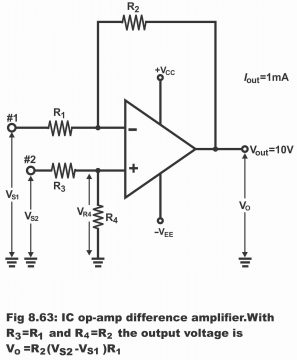Difference Amplifier with Equation Example
Difference Amplifier
An amplifier that amplifies the difference existing between two input signals and provides an output in proportion to this difference is called a difference amplifier. In other words, an amplifier that provides output equal to or in proportion to the difference between two input signals is known as a difference or Subtractor amplifier. A difference amplifier has been shown in figure 8.63.
Figure 8.63 – IC op-amp difference amplifier. With R3-R1 and R4=R2, the output voltage is Vo= R2 (VS2-VS1)/R1
A difference amplifier comprises two inputs (i.e. inverting and non-inverting) and like other operational amplifier circuits, a practical amplifier also has negative feedback. As inputs are supplied on inverting and non-inverting terminals of a difference amplifier circuit, therefore this type of amplifier is a combination or collection of both inverting and non–inverting amplifiers. If input terminal 2 is grounded, the circuit operates as an inverting amplifier. Signal VS2 provides V4 getting divided parallel to resistor R3 and R4 which are received on the non-inverting input of the operational amplifier. If terminal 1 is grounded, R1 and R2 operate as feedback components of non- inverting input of an operational amplifier. Thus, voltage V4 amplify as an input provided on a non – inverting amplifier. When VS2 value is zero, i.e. VS2 = 0, the value of first output will then be:
V01 = -R2/R1 x VS1
When VS1 value is zero, then VR4 and V02 values will be as follows:
VR4 = R4/ R3 +R4 x VS2
V02 = R1+R2 /R1 x VR4
By substituting value of VR4 in the above-mentioned equation,
V02 = R1+R2 /R1 x R4/R3x R4 x VS2
If R1 = R2 = R3 = R4, then
VO2 = R4/R1 x VS2 =R2/ R1 x VS2
The value of output signal in the presence of both the signals will be as follows:
V0 = V02+V01
= R2/R1 x VS2 – R2/R1 x VS1
=R2/R1 x (VS2-VS1)
Or V0 = Av (VS2-VS1)
Here Av means voltage gain and its value is equivalent to R1 and R2. It is obvious from the above equation that each input voltage has been multiplied by its input gain and the resulting total output equals to the difference between the two. Suppose that R1=R2, then the value of output voltage would be as follows:
V0= (VS2 – VS1) = Difference of the two-input ratio
Next Topic: Inverting Amplifier
Previous Topic: Introduction to the Comparator and Working
For electronics and programming-related projects visit my YouTube channel.

